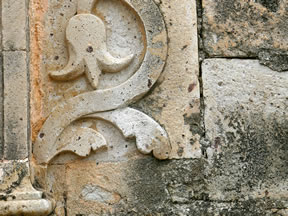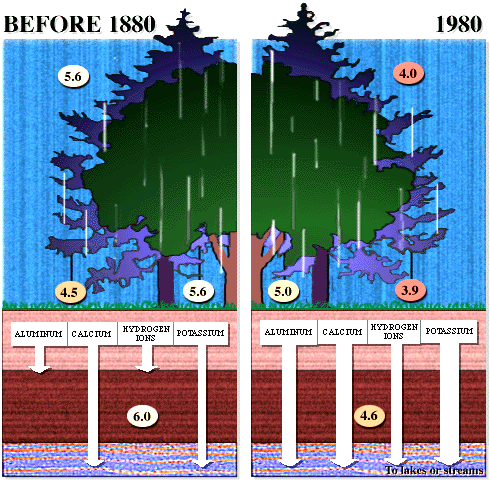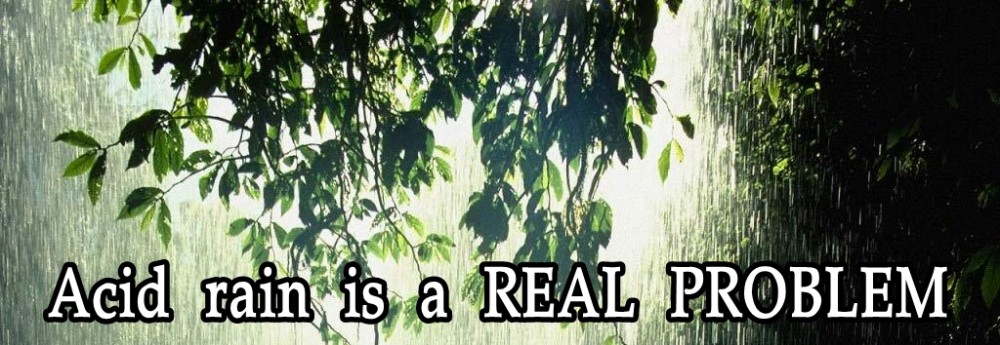The impact of the acidic rain for Singapore:
- Speed up the rate of corrosion to buildings and sculptures
- Harm to marine life
- Reduce growth rate, injury or death of forests
Speed up the rate of corrosion to buildings and sculptures
Emission of sulfur dioxide and nitrogen oxide, react with the water vapour in the atmosphere causing acidic rain. Acidic rain will increase the rate of corrosion to building materials, especially marble and limestone. These two materials consist calcium carbonate which easily reacts with acids. Have you ever seen deteriorating buildings and sculptures that have a corrosion effect caused by acid rain?

Picture shows the accelerating corrosion effect on marble and limestone buildings
On the other hand, acidic rain not only corrode the calcium carbonate molecules materials, but also can damage certain type of metals such as nickel, zinc, copper and bronze. Although metal corrosion is primary caused by oxygen and moisture, acidic rain will increase the corrosion rate of metal dramatically.

Picture shows the accelerating corrosion effect on metallic part of buildings
Harm to marine life
Have you been to any of the beaches in Singapore? All of us did, and have you ever seen dead fishes lying around the sand beaches? It’s an common site nowadays but what causes it? One of the main reason is due to the acidic rain.
According to a study conducted in 2009 by NUS professor and students, the water in the stream on nature reserve is found to be pH 4.4-4.7, which is considered very acidic as compared to the desirable range set by the National Environment Agency (pH 6.5-9.5).
With such acidic water found in our stream (which eventually will flow to the sea), it certainly affects the ecosystem and the diversity of the plant and animals. At pH level less than 5.5, certain seafood such as crabs, shrimps and fishes can’t survive well and this greatly affect the whole ecosystem. As a result, we are seeing many dead fishes floating on the beaches in Singapore.
One such strong example that acidic rain does harm our marine life is the Singapore Freshwater Crab. Such crab is only found in Singapore and as the name implies, found in freshwater area.
Singapore Freshwater Crab is now inside the list of the Top 100 most threatened species in the world. Why is that so?

Diagram shows details of the Singapore freshwater crab. It can be found in streams at around Bukit Batok, Bukit Timah and Bukit Gombak in Singapore.
The reason being is that such freshwater crab found in urban Singapore is a nocturnal creature and feeds on detritus and worms found in the stream bed. It prefers to have an environment which relatively clean and fast-flowing streams in the highlands with a near neutral pH and high concentration of dissolved oxygen. It is generally absent in waters that are acidic or in area that are disturbed with high siltation.
Due to the acidic rain that we have in Singapore, it affects the pH level of our sea,rivers and streams, and thus this drastically affects the population of Singapore Freshwater Crab so much that it is listed by the International Union for Conservation of Nature (IUCN) as a critically endangered species. This is definitely a cause for concern towards our local marine life.
Another example is the mass fish deaths spotted at Pasir Ris Beach on 28 Feb 2015, following tonnes of dead fish that affected farmers at Johor, Malaysia recently. Singapore fish farmers said that the problem was getting worse as compared to a similar event that happened last year.
According to a statement made by Agri-Food & Veterinary Authority (AVA). The problem was due to the low levels of dissolved oxygen in the lake or a plankton bloom. As lakes become more acidic due to acid rain, the types and numbers of organisms in aquatic environment will be changed. Some types of plants and animals are able to tolerate with acid waters, but some cannot. At a lower pH level, some types of fish will not be able to tolerate and die. Hence, it will cause the disequilibrium of aquatic system.

Mass death fish in fish farm located in Lim Chu Kang.
In order to protect these marine life, the 3 Big companies (Exxon Mobil, Shell and SRC) have taken up measures to reduce the emission of sulfur in the air. For example, SRC have came up with a plan to treat the petrol it produces to under 0.005% sulfur. All these efforts from the 3 big companies will help Singapore to meet several the WHO standards by 2020.
With the effort made by the big three companies that mainly contributes to our sulfur emission and the new introduction of Ultra Low Sulfur Diesel back in 2006, the joint forces will reduce the acidic rain in Singapore.
All Singaporeans and our team are very excited to see the new progress of the reduced emission in sulfur, we are all looking forward to a less acidic rain in Singapore and hopefully no more dead fishes and crabs lying on the beaches and Singapore Freshwater Crab will be out of the Top 100 endangered species in the world! We are definitely looking forward to this piece of news! 🙂
Reduce growth rate, injury or death of forests (Evergreen rain forest, mangrove, freshwater swamp forest)
As acidic water that seeps into the ground dissolves the nutrients and minerals, such as calcium and magnesium, acid rain is one of the serious types of pollution that may causes the lost of nutrients and minerals in the soil. Acid rain also release toxic element, such as aluminium into the soil, which will cause plants to have difficulty on absorbing water through soil. This causes leaves to fall off and may cause the decreasing of forest yield.

Picture shows the acid rain damage on forests

Diagram of the situation in a typical forest before acid rain (~1880) and after acid rain has become important. Note that on the right panel the soils are now releasing aluminum and hydrogen ions, and the pH of the exported water is very acid (pH = 4.6).
For example, the yield of Bukit Timah Nature Reserve forest is decreasing due to the loss of species that are able to help re-seeding plants.


